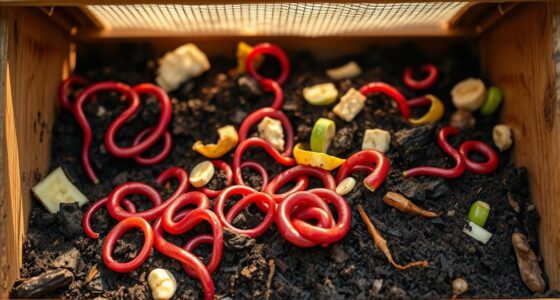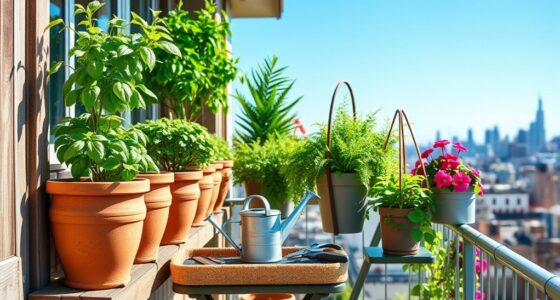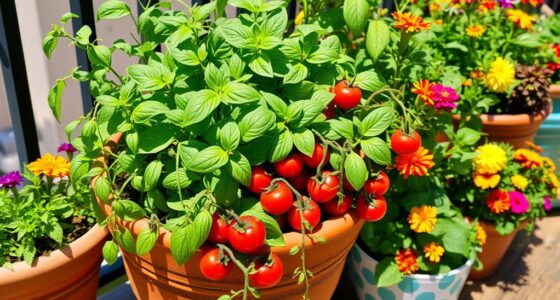Revitalizing urban soils is key to turning polluted ground into productive, green spaces. By using soil remediation techniques like bioremediation or soil washing, you can remove or neutralize harmful pollutants, making the soil safe for gardening. Implementing pollution mitigation strategies such as planting native plants and installing green infrastructure helps stabilize the soil and reduce runoff. If you want to discover more ways to create healthy urban gardens on contaminated ground, keep exploring these effective methods.
Key Takeaways
- Soil remediation techniques, like bioremediation and soil washing, make polluted urban ground safe for gardening.
- Using pollution-tolerant plant species helps stabilize contaminated soils and prevent toxin uptake.
- Implementing green infrastructure and pollution mitigation strategies reduces further soil contamination.
- Restored soils support healthy plant growth, enhancing urban biodiversity and community green spaces.
- Urban soil revival improves air and water quality, making city gardens safer and more sustainable.

Have you ever considered how revitalizing urban soils can transform city life? When you look at concrete jungles, it’s easy to forget that beneath the surface, soil quality plays a crucial role in supporting healthy plants, clean air, and a sustainable environment. Urban soils often suffer from pollution, heavy metal contamination, and compaction due to industrial activity and dense construction. But there’s hope—soil remediation techniques can turn these degraded grounds into thriving spaces for gardening and ecological restoration. By actively addressing soil pollution and implementing pollution mitigation strategies, you can help restore the natural functions of urban soils, making your city greener and more resilient.
Soil remediation is a key step in transforming contaminated urban ground into safe, productive soil. It involves removing or neutralizing pollutants that could pose risks to plants, animals, or humans. Techniques such as soil washing, bioremediation, and soil excavation target specific contaminants like lead, hydrocarbons, or heavy metals. When you undertake soil remediation, you’re not just cleaning the ground; you’re creating a foundation for sustainable urban gardening, where plants can grow without fear of absorbing harmful substances. This process also helps mitigate pollution by reducing the ongoing release of toxins into the environment, improving overall air and water quality. It’s a proactive way to tackle the legacy of industrial pollution that haunts many city landscapes. Incorporating soil restoration practices is essential for achieving long-term environmental health in urban areas.
Pollution mitigation goes hand in hand with soil remediation. It involves implementing measures to prevent further contamination and minimize the impact of existing pollutants. For example, introducing green infrastructure like permeable pavements, green roofs, and vegetative buffers can reduce runoff carrying pollutants into soil and waterways. Planting native or pollutant-tolerant species can also help absorb residual toxins, stabilizing the soil and preventing erosion. As you work on pollution mitigation, you contribute to a healthier urban ecosystem, making the soil safer for planting vegetables, herbs, or ornamental plants. This approach helps break the cycle of pollution, promoting cleaner air and water while creating more livable, accessible green spaces.
Reviving urban soils isn’t just about planting; it’s about restoring the land’s natural capacity to support life. When you focus on soil remediation and pollution mitigation, you’re actively participating in a larger movement toward sustainable city living. You help transform abandoned lots or contaminated patches into vibrant gardens and community spaces that benefit everyone. By understanding the importance of soil health, and taking steps to remediate and mitigate pollution, you can turn polluted ground into fertile ground—literally—supporting biodiversity, improving air quality, and fostering a renewed sense of connection between residents and their environment. It’s a powerful way to make your city a healthier, more beautiful place to live.
Frequently Asked Questions
Which Soil Testing Methods Are Most Accurate for Urban Environments?
When you want accurate soil testing, focus on soil sampling and laboratory analysis. Soil sampling involves collecting representative samples from different spots to get an overall picture. Then, send these samples to a certified lab for detailed analysis. This method provides precise data on contaminants, nutrients, and pH levels. For urban environments, it’s especially critical to select reputable labs to guarantee reliable results, guiding safe gardening practices.
Can Native Plants Thrive in Contaminated Urban Soils?
You might wonder if native plants can flourish amid challenging conditions. The good news is that many native plants have impressive resilience and soil contamination tolerance. While they can adapt to some urban soil issues, their success depends on the level of pollution. By selecting species known for their hardy nature and improving soil conditions where possible, you give your native plants a better shot at thriving despite urban soil complexities.
How Long Does It Take to Remediate Polluted Urban Ground?
You’re wondering how long soil remediation takes for polluted urban ground. It varies depending on contamination levels and methods used, but typically, it can take months to several years. The contamination timeline helps determine the extent of cleanup needed. You’ll want to assess soil for pollutants, then implement remediation techniques like soil washing or bioremediation, which gradually restore soil health and reduce pollutants over time.
Are There Affordable DIY Solutions for Urban Soil Detoxification?
Imagine you’re a modern-day alchemist seeking affordable DIY soil detox solutions. You can start with composting hacks to break down contaminants naturally, enriching your soil. Layer your soil thoughtfully, adding clean materials to isolate pollutants. These simple techniques make urban gardening feasible without costly equipment. While not a magic cure, combining composting hacks and soil layering helps you improve contaminated ground gradually, turning urban spaces into thriving, healthy gardens.
What Are the Health Risks of Gardening in Polluted Urban Soil?
You should be aware that gardening in polluted soil can pose health risks due to soil contamination, which may introduce harmful chemicals or heavy metals. These toxins can lead to plant toxicity, affecting both your health and your plants. Handling contaminated soil increases exposure risks, so it is crucial to use protective gear and consider soil testing. By understanding these hazards, you can take steps to minimize risks and enjoy gardening safely.
Conclusion
As you breathe new life into polluted urban soils, remember you’re planting hope in a concrete jungle. With every careful amendment and mindful gardening choice, you’re transforming troubled ground into a vibrant tapestry of growth. Think of yourself as a gardener of the city’s future, turning scars into stories of resilience. Your hands craft a lush, green symphony amid the gray—a demonstration that even in tough soil, beauty and renewal can flourish.









